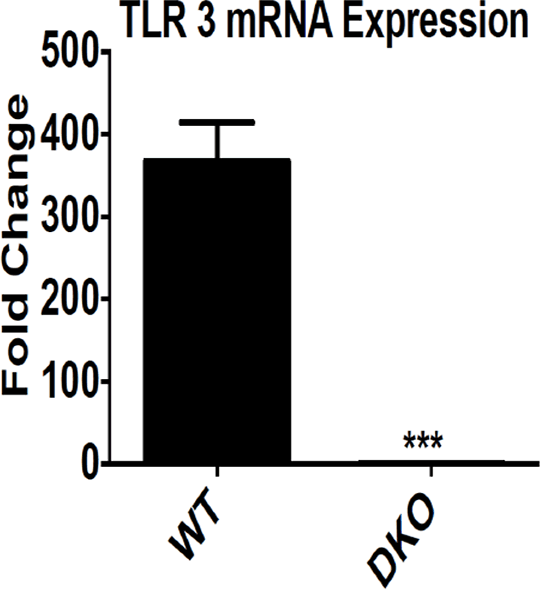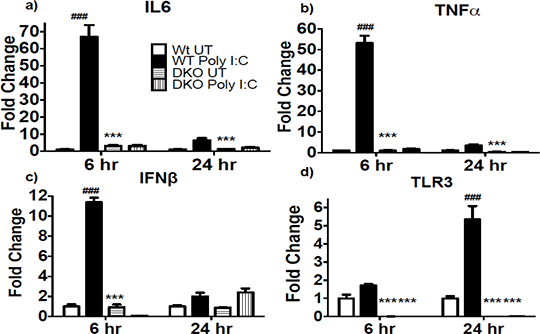The Role of DNA Methylation in Toll-Like Receptor 3 Expression Introduction: Toll-like receptors (TLRs) are pattern recognition receptors integral to the innate immune response. TLR signalling culminates in the production of cytokines which initiate the inflammatory response. TLR expression varies with cell type and disease progression (1). DNA methylation is an epigenetic mechanism, which the cell employs to regulate gene expression. A family of enzymes known as DNA methyltransferases (DNMT) catalyse the addition of a methyl group to the 5’ position of cytosine in the context of CG dinucleotides in DNA (2). It is not known if epigenetic mechanisms such as DNA methylation regulate TLR expression. Methods: In this study, we examined the basal mRNA expression, by QRT-PCR, of TLRs using intestinal epithelial wild-type (WT) and a double knockout HCT116 cell line (DKO) where both DNMT 1 and DNMT 3b genes are knocked out (3). We also stimulated WT and DKO cells with Poly I: C (10µg/ml), the TLR3 synthetic ligand, for 6 and 24 hours. Relative mRNA expression of TLR3, IL6, TNFα and IFNγ were quantified and the relative fold chage calculated using the 2(-Delta Delta C(T)) Method (no units). Statistical analysis involved using unpaired student’s t-tests and Analysis of Variance (ANOVA) where appropriate (p < 0.05 was considered significant). Results: Notably, basal TLR3 mRNA expression was significantly reduced in HCT116 DKO cells (Fig. 1: 367.1 fold greater expression in Wt cells vs. DKO, n=9, p<0.001). Following 6 hr stimulation with Poly I:C, IL-6 mRNA expression significantly increased in WT cells (Fig 2a: 67 fold increase, n=9, p<0.001) as well as following 24 hour stimulation (6.3 fold increase, n=9, p<0.001) but not in the DKO cells. TNF-α displayed the same pattern as IL-6 (Fig 2b: 53 fold increase, n=9, p<0.001) at 6 hours and at 24 hours (3.4 fold increase, n=9, p<0.001). IFN-ß mRNA expression also increased in WT cells exclusively (Fig 2c: 11 fold increase, n=9, p<0.001) at 6 hours and at 24 hours (2 fold increase, n=9, p<0.001). Furthermore, TLR3 mRNA expression increased in WT cells at 24 hours (Fig 2d: 5 fold, n=9, p<0.001) but not at 6 hours.  
Conclusion: Our findings indicate that DNA methylation is implicated in the regulation and signalling of TLR3. Therapeutic targeting of the epigenome might provide new opportunities for targeting the innate immune system for inflammatory disorders. References (1) Akira S et al., Pathogen recognition and innate immunity. Cell. 2006 Feb 24;124(4):783-801. Review. PubMed PMID: 16497588. (2) Bestor TH. The DNA methyltransferases of mammals. Hum Mol Genet. 2000 Oct;9(16):2395-402. Review. PubMed PMID: 11005794. (3) Rhee I et al., DNMT1 and DNMT3b cooperate to silence genes in human cancer cells. Nature. 2002 Apr 4;416(6880):552-6. |



